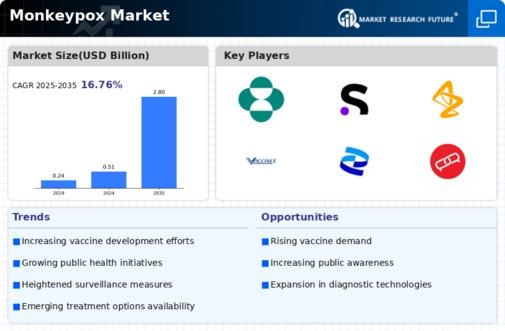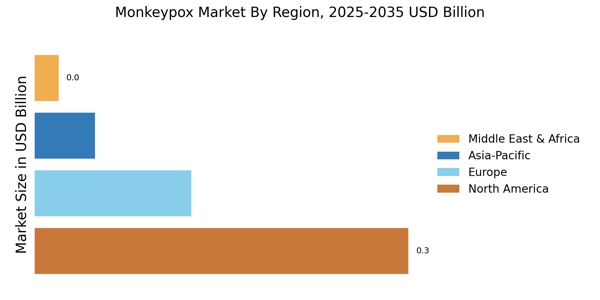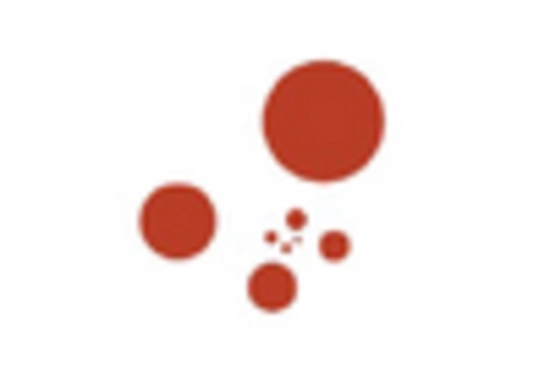Government Initiatives and Funding
Government initiatives and funding play a significant role in shaping the Monkeypox Market. Various countries have recognized the need to allocate resources towards monkeypox prevention and control measures. Increased funding for research, surveillance, and public health campaigns has been observed, reflecting a commitment to addressing the disease. For instance, several governments have launched initiatives aimed at enhancing laboratory capacity and improving access to diagnostic tools. This financial support is likely to stimulate innovation within the market, encouraging the development of new treatments and vaccines. As governments prioritize monkeypox in their health agendas, the Monkeypox Market is expected to experience growth driven by enhanced public health infrastructure and increased collaboration between stakeholders.
Advancements in Vaccine Development
Advancements in vaccine development represent a crucial driver for the Monkeypox Market. Recent breakthroughs in vaccine technology have led to the creation of more effective and safer vaccines against monkeypox. The emergence of new vaccine candidates, including those utilizing recombinant DNA technology, has garnered attention from health authorities and researchers alike. As vaccination campaigns gain momentum, the market is likely to witness increased demand for these innovative products. Furthermore, the World Health Organization has emphasized the importance of vaccination in controlling monkeypox outbreaks, which may further bolster market growth. The Monkeypox Market stands to benefit from these advancements, as they not only enhance public health responses but also create opportunities for pharmaceutical companies to expand their portfolios.
Rising Incidence of Monkeypox Cases
The increasing incidence of monkeypox cases has emerged as a pivotal driver for the Monkeypox Market. Recent data indicates a notable rise in reported cases, prompting health authorities to prioritize monitoring and response strategies. This surge in cases has catalyzed the demand for effective diagnostic tools and treatment options, thereby stimulating market growth. As healthcare systems adapt to the evolving epidemiological landscape, investments in research and development are likely to escalate. The urgency to address monkeypox outbreaks has led to collaborations between public health organizations and pharmaceutical companies, fostering innovation in vaccine and therapeutic development. Consequently, the Monkeypox Market is poised for expansion as stakeholders respond to the pressing need for comprehensive healthcare solutions.
International Collaboration in Disease Control
International collaboration in disease control is emerging as a key driver for the Monkeypox Market. The interconnectedness of global health systems has prompted countries to work together in addressing monkeypox outbreaks. Collaborative efforts, such as information sharing and joint research initiatives, are likely to enhance the understanding of the disease and improve response strategies. Organizations like the World Health Organization are facilitating partnerships that aim to strengthen surveillance and response capabilities. This collaborative approach not only fosters innovation in treatment and prevention but also encourages the sharing of best practices among nations. As a result, the Monkeypox Market is expected to benefit from these international efforts, leading to improved health outcomes and market growth.
Growing Public Awareness of Infectious Diseases
The growing public awareness of infectious diseases, including monkeypox, serves as a vital driver for the Monkeypox Market. As information about monkeypox becomes more accessible, individuals are increasingly informed about the symptoms, transmission, and prevention strategies associated with the disease. This heightened awareness has led to a greater demand for diagnostic testing and treatment options. Public health campaigns aimed at educating communities about monkeypox are likely to contribute to early detection and intervention, ultimately reducing transmission rates. Consequently, the Monkeypox Market may experience growth as healthcare providers respond to the rising demand for educational resources and healthcare services related to monkeypox.


















Leave a Comment